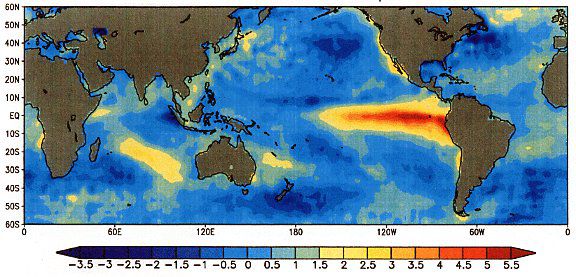-
 VSC, PVC
VSC, PVC
-
 Isomerase
Isomerase
-
 Biodiversity
Biodiversity
-
 Gliding
Gliding
-
 Cannula
Cannula
-
 Aerobic glycolysis
Aerobic glycolysis
-
 SOHO
SOHO
-
 CGS system
CGS system
-
 Obliquity
Obliquity
-
 Phases of a planet
Phases of a planet
-
 Baleen plate
Baleen plate
-
 Mitosis
Mitosis
-
 Sensitive Natural Space
Sensitive Natural Space
-
 Reaction net energy balance
Reaction net energy balance
-
 Selenocysteine
Selenocysteine
-
 Diagenesis
Diagenesis
-
 GDP
GDP
-
 Pedogenesis
Pedogenesis
-
 Computer science
Computer science
-
 Migmatite
Migmatite
-
 Geodetic precession
Geodetic precession
-
 Fungicide
Fungicide
-
 Exif
Exif
-
 Earth Summit
Earth Summit
-
 Mango
Mango
-
 Scapula
Scapula
-
 Giant magnetoresistance
Giant magnetoresistance
-
 Absolute temperature
Absolute temperature
-
 Whopping cough
Whopping cough
-
 Transpiration
Transpiration
El Niño
El Niño is a climatic phenomenon whose origin is not understood very well. As opposed to La Niña, it causes a rise in temperature of the surface water (about 10 metres) in the East Pacific Ocean, around the equator (see the map below).
El Niño, the bad boy of the climate
The name El Niño - which means " child " in Spanish -refers to Jesus, since this phenomenon reaches its peak around Christmas. Peruvian fishermen gave this name to the corresponding cold marine current.
This phenomenon was discovered in the 1920s by Sir Gilbert Walker, an English physicist who demonstrated the Southern oscillation linked to El Niño.
The climatic consequences of El Niño
Just like La Niña, El Niño does not affect all parts of the globe in the same way.
Normally, in the Pacific Ocean, around the equator, the trade winds blow from the East (America) to the West (Australia and Asia). This has the effect of pushing the warm surface waters to the West, where it consequently produces heavy precipitation (due to the heat and humidity) and the rise of cold water along the American coast.
The El Niño climatic phenomenon corresponds to an inversion of the trade winds in the Pacific. © ide.fr
But when the Earth is affected by El Niño, trade winds tend to reverse. Thus the waters near Australia and Asia are colder , which causes droughts. Hurricanes form in the middle of the Pacific and affect Polynesia. Finally, the water along the American coast warms, causing an increase in precipitation and a rarefaction of fish on the surface, because warm waters are not favourable to the proliferation of nutrients.
El Niño years
The last occurrences of the phenomenon were in 2009-2010, 2006-2007, 2002, 2003, 1997-1998, 1994-1995, 1990-1993, 1986-1988, 1982-1983, etc.
 El Niño caused temperature anomalies in 1997. The warm colours show a positive anomaly (therefore an increase in temperature). One can see that the temperature increased across the Western Pacific and along the American coasts. © NOAA, public domain
El Niño caused temperature anomalies in 1997. The warm colours show a positive anomaly (therefore an increase in temperature). One can see that the temperature increased across the Western Pacific and along the American coasts. © NOAA, public domain
Latest
Fill out my online form.



